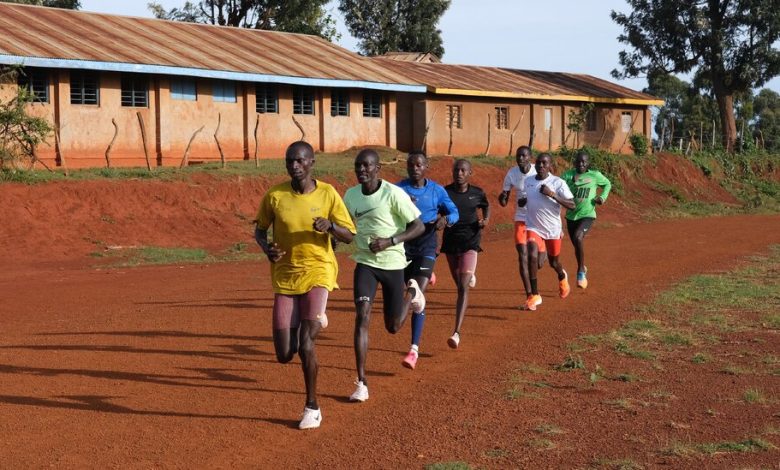A Hotbed of Distance Running Talent Emerges in Uganda

With a mile to go in the 2017 World Cross Country Championships, Joshua Cheptegei had one thing on his mind: win gold for his country on home soil.
It was a balmy afternoon in the Ugandan capital of Kampala, and against a field of far more seasoned athletes, he was closing in on his goal. Halfway through the biennial event, in which the world’s top distance runners compete over 10 kilometers of grass, mud and occasional barriers, he had gapped the field with a surge so elegant that it looked like he was floating.
Two hours earlier, his compatriot Jacob Kiplimo had hoisted the red, black, gold, and grey crowned crane of the Ugandan flag after winning the under-20 race. The raucous crowd, which included the Ugandan President Yoweri Museveni, expected Cheptegei to do the same.
Now he was hanging on for dear life, determined to prove that Uganda, long overlooked in the distance running world, could hold its own against the sport’s powerhouses, Kenya and Ethiopia. But the storybook ending, on this day, would not come to pass: In the final half-mile, as his body fended off dehydration, Cheptegei’s engine sputtered. He slowed to an agonizing shuffle, coming in 30th place out of 136 finishers.
Cheptegei’s near-triumph would nonetheless prove to be a prelude to a Ugandan running renaissance. Two years later, he won the 2019 World Cross Country Championships in Denmark. Uganda’s men took the team title.
Since then, Cheptegei has secured his place on the list of distance running’s all-time greats, with an Olympic gold medal and two World Championship titles on the track, as well as world records in the 5,000 and 10,000 meters. Kiplimo, who dethroned Cheptegei as the current World Cross Country champion in February, now holds the half-marathon world record. In 2019, Halimah Nakaayi won the World Championship title in the 800 meters, and, in 2021, Peruth Chemutai won the Olympic gold medal in the 3,000-meter steeplechase.

Gold medalist Joshua Cheptegei, of Uganda, left, and Bronze medalist Jacob Kiplimo, of Uganda, greeted fans after the men’s 10000-meter run final at the World Athletics Championships last year.Credit…Charlie Riedel/Associated Press
In and around Kapchorwa, a small town in the foothills of Mount Elgon, a 14,000-foot extinct volcano that straddles the Kenyan border, hundreds of youngsters are hitting the roads with dreams of future glory. Though Uganda’s volume of talent still lags behind its Kenyan and Ethiopian rivals, the magnitude of its rise has been remarkable.
“Every year, as a country, we’re getting better and better,” Cheptegei said on an April afternoon, as he looked ahead to defending his 10,000-meter title at this month’s World Athletics Championships in Budapest. “The Mount Elgon region has always been home to running talent, and we’re only just beginning to showcase it.”
Uganda’s ascent, in many ways, is an outgrowth of longstanding success in Kenya. Since 1964, that country has won 105 Olympic medals in running events from 400 meters to the marathon; Kenya has also produced six of the 10 fastest male marathoners in history, and five of the 10 fastest women.
These exploits have been mainly concentrated among the Kalenjin, a community of nine closely related tribes descended from pastoralists that migrated south over the last few thousand years from the Nile River Valley. Most of the seven million Kalenjin today live in Kenya’s western highlands, where altitudes ranging from 6,000 to 9,000 feet help them develop more oxygen-carrying red blood cells and greater lung capacities. Research has also shown that Kalenjin, on average, have especially thin lower legs and a high leg-length-to-torso ratio, which facilitates greater running economy, or the ability to make more efficient use of oxygen.
There are Kalenjin in Uganda, too, and if it weren’t for the quirks of colonial history, there would be more: The original borders of Britain’s Uganda Protectorate, hashed out by mustachioed bureaucrats in 1894, encompassed the bulk of the Kalenjin territory that is part of Kenya today. Adjustments to the boundary in 1902, driven by the desire to unify administration of a railway from the coast, unwittingly paved the way for Kenya’s future running triumphs. Yet the new line, which cut through the crest of Elgon, severed one Kalenjin tribe, the Sabaot, in two. The descendants of those left in Uganda, who number roughly 300,000, live primarily in three districts on Elgon’s western flanks — an area of striking natural beauty known for its waterfalls, sweeping vistas and alpine forests.
It is here that Ugandan running is now thriving, though the region’s talent took time to develop. While Kenya enjoyed relative stability in the decades after independence, Uganda was at war for much of the 1970s and 1980s. Lawlessness pervaded the Mount Elgon region until the turn of the century: Bandits from neighboring tribes would sweep in at night and conduct raids on cattle, often killing locals in the process.
The area was also slow to modernize. Until the 1990s, the ancestors of many current athletes, including Cheptegei, Kiplimo and Chemutai, lived inside the forests of Elgon’s upper belt, part of a small group of Sabaot that subsisted on milk, honey and meat from antelope and buffalo they hunted. Here, 9,000 feet up, there were no roads or schools, and no pipeline into competitive athletics. But according to Moses Kiptala, an elder who grew up in this community, endurance was of great value: The group’s method of persistence hunting involved chasing animals for hours until they overheated.
Kiplimo, who comes from a family of runners and had planned to contest the 5,000 and 10,000 meters in Budapest before being sidelined by an injured hamstring, is of particularly distinguished stock. Kiptala recalls Kiplimo’s grandfather being such a prolific hunter that the community called him Simba, or Lion.
Much had changed by the time today’s crop of stars were born: In 1983, Uganda’s government began resettling the group, known as the Mosopisiek, downslope from the forest to make way for a national park. Most are now small-scale farmers. The resettlement process, Kiptala said, was traumatic, but it also helped unlock running talent. Through school, children could access competitions, and by the early 2000s, athletes from the Elgon region were beginning to appear in World Championship and Olympic finals.
Uganda’s first champion of this period was a runner from the country’s north, Dorcus Inzikuru, who won the 3000-meter steeplechase at the 2005 World Championships in Helsinki. Elgon’s watershed moment came seven years later, when the Kapchorwa native Stephen Kiprotich notched an upset win in the 2012 London Olympic marathon — the country’s first Olympic gold since 1972. He doubled down with a marathon title the following year in Moscow.
“Many Kenyans were saying London was a fluke, so I had to prove them wrong,” Kiprotich said.
Among the legions inspired by those performances was a teenage Cheptegei, who had also grown up in Kapchorwa with dreams of running glory. His parents, who insisted he enroll in college, were skeptical. But his progress, highlighted by a 10,000-meter world junior title, was so impressive that even President Museveni urged him to drop the books and focus full-time on athletics.
Like many Ugandan runners before him, Cheptegei left for Kenya, where there were more elites to train with and more sophisticated coaching. In 2016, determined to raise the sport’s profile at home, he convinced his management, the Netherlands-based Global Sports Communication, to establish an elite group in Kapchorwa.
Seven years later, Cheptegei is not only a national icon; along with coach Addy Ruiter, he’s pieced together a squad of two dozen globally competitive athletes, who live together in a stone and brick facility known as the Joshua Cheptegei Training Center, on the slopes above the town. An affiliated camp for up-and-coming junior athletes is a short drive away in Kween, a neighboring district.
Other management groups, including Kiplimo’s Italy-based Rosa & Associati, have opened camps in the area as well, drawn both to the concentration of talent and the training environment. Though Kapchorwa sits at a slightly lower altitude than the main training hubs in Kenya and Ethiopia, the town’s location halfway up a mountain enables greater versatility. Ruiter, a 60-year-old former triathlete who left a desk job at Ikea to move here from the Netherlands in 2019, said his athletes benefit from long runs that reach as high as 10,000 feet, as well as faster sessions at altitudes as low as 3,500 feet.
While a structure for continued success is now in place, Ruiter was quick to stress that the size of Uganda’s talent pool will never quite measure up to Kenya’s or Ethiopia’s. He also described Cheptegei and Kiplimo as “once-in-a-generation talents” and said it could be a while before Uganda sees another athlete of their caliber. Eventually, though, he believes more champions from Mount Elgon will emerge.
Other roadblocks could still manifest. In recent years, Kenya’s running pre-eminence has been marred by the specter of doping: As of Aug. 9, there were 64 Kenyan athletes ineligible to compete in World Athletics events because of drug-related violations. There were no Ugandans on the list, though earlier this month, Janat Chemusto, a 1,500-meter runner who trains in the Cheptegei camp, was provisionally suspended by the Athletics Integrity Unit, which investigates doping in the sport. In a statement, Erik van Leeuwen of Global Sports Communication said Chemusto would be defending her case but offered no further comment.
For Cheptegei, the focus is now on the World Championships in Budapest: he’s expected to contend for the 10,000 meter title on Aug. 20 and may double back to vie for the podium in the 5,000 meters as well. And, in December, he will make his marathon debut in Valencia — the same city where he set his 10,000-meter record in 2020. Kiplimo has plans to eventually move up to the marathon, too, where the money is greater and new record-breaking opportunities await.
On that day in April, as he spoke from inside his camp following the day’s training session, Cheptegei said he was simply grateful for the journey that he and his country had taken so far — even the rare occasions when things hadn’t quite worked out.
“It’s one of those incidents that built me mentally,” he said of the 2017 race in Kampala. “I had two options: Allow it to break me; or gather myself together and build an inspirational story.”




